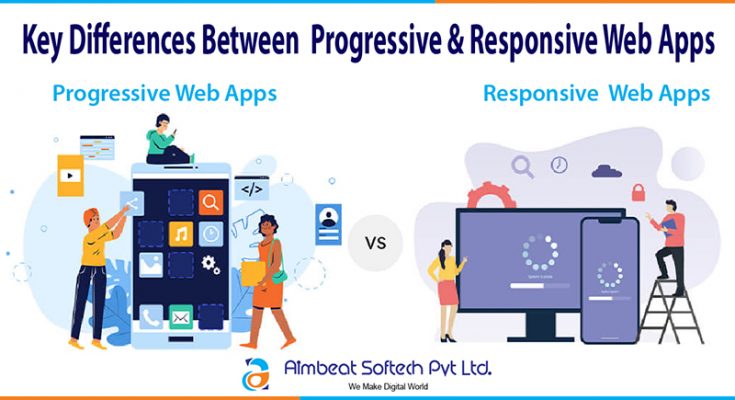Smartphones have become an important part of our everyday lives. We might go out of our house without a wallet but we don’t forget to take our cellphones with us. From booking a cab to ordering food and Online Payments. Our dependency has increased on Mobile Applications. So in today’s era, we need to build better and unique applications.
Today, we live in a world where you need to serve a better and unique experience to the users. For example, if someone is wanting to purchase a t-shirt on the web & he came to your website and your website is taking too much time to load, and boom you lost your client. Users will easily switch to another high-performing website with a better user experience.
To fill this need, technologies have developed radically. From applications that could run just a particular gadget to those that are suitable with all, we have made considerable progress. So is the situation with responsive and intensifying web applications. Both have appreciated a decent amount of prominence, yet for totally various reasons. Nonetheless, with two such choices on the list, you might face difficulties if you are planning to choose only one option for your business. To facilitate this battle, we have drawn a complete correlation between Progressive and Responsive web applications. Look down for all the information.
Progressive VS Responsive Web Apps: Which One Is Good For You?
Every application developer endeavors to convey highly-functional and great applications for clients. The following are a portion of the highlights that compensate for it alongside a definite investigation of how reformist and responsive applications react to each.
Speed: Progressive Web Apps (PWA) will in general win the fight with regards to speed. While responsive applications, as well, offer extraordinary speed, PWAs are a stride ahead. This permits you to improve the viability of your portable application as it stacks quicker on all devices. PWAs are viable with old browsers which gives them an edge. It also communicates with modern features like offline support, pushes notifications, native audio & video capturing features.
Work Offline: This permits users to use the app offline. Responsive applications, in any case, are not fit for working disconnected, while PWAs can store enormous information empowering use without the web. It also decrease buffering time and has proven to be beneficial for global brands. For example, ZEE 5, a web-based streaming stage had the option to cut down the application’s buffering time by a monstrous half, and furthermore permitted clients to surf through their inventory on disconnected mode with PWA.
Cost Efficiency: Cost Efficiency is another matter key to all business choices. It’s consistently shown to evaluate if the investment you are making for application advancement is justified, despite all the trouble. Responsive applications can adjust to various screen gadgets utilizing single coding. This defines that you just need to build up a responsive application once with one code, and from that point, it’s on the cell phone to naturally introduce the site per its screen size. Then again, PWAs are to be created utilizing various languages like Javascript, HTML 5, or CSS, each for explicit screens. As it distinguishes the screen of the host gadget, it grandstands the modified rendition of your site. Accordingly, the designer needs to create various forms for various screen sizes which makes PWA costly. In any case, its different highlights like high speed, native-like experience, etc. make up for the added cost. Additionally, it draws attention to a demonstrated history of improved ROI, particularly on account of Best Western River North Hotel where it brought about an astounding 300% expansion in incomes present turning on PWA.
Client Experience: An amazing and neighborly client experience is the way to progress for organizations today. PWA tops the rundown with regards to conveying quality UX. It makes your site look rich and outstandingly created. Dissimilar to local applications that can run uniquely on a particular stage like iOS or Android, PWAs are viable with various stages yet convey a local like experience.
Accessibility: PWA can be handily saved money on the gadget’s landing page guaranteeing simple availability as now clients won’t need to look for it in the program without fail. As the client taps the application symbol from their rundown of applications on the home screen, PWA dispatches full-screen. Its UI invigorates at 60fps.
Search Engine Optimization and SEM: Creating a site isn’t sufficient. It needs SEO and SEM too so the audience can find it. Both Responsive and Progressive applications are reasonable for SEO and SEM. They assist you with using keywords in the site content and permit web creeping via web indexes to increase visibility. Every one of these elements assumes a significant part in the positioning of your site on the web index result page. One can likewise advance business by means of paid internet searcher promoting.
Conclusion – Every Topic which we have discussed in this blog for example like speed, SEO & SEM, User Experience, etc., are important points of Online Business. While making an e-commerce website you should keep in a mind all these points. Eventually, there is no exact answer that could be suitable for everybody. Everything relies upon your business requirements. For instance, if you have a start-up project with limited funds, then you might have to think before investing a huge amount into app development. However, you ought to likewise consider the drawn-out outcomes application advancement isn’t something you would need to embrace each at that point and now. The expectation that the present blog would have assisted you with understanding the two innovations better and settle on the correct choice.




